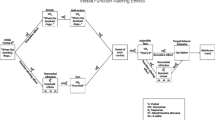Abstract
Behavior analysts should distinguish between the intraverbal, as a class of verbal operants, and intraverbal control, the potentiating effect, however slight, of a verbal antecedent on a verbal response. If it is to serve an explanatory function, the term intraverbal, as a class of verbal operants, should be restricted to those cases in which a verbal antecedent, as the result of a history of contiguous or correlated usage, is sufficient to evoke the putative intraverbal response. Intraverbal control is pervasive in verbal behavior, but since it is typically just one of many concurrent variables that determine the form of a verbal response, such multiply controlled responses are not usefully called “intraverbals.” Because intraverbals and their controlling variables have invariant formal properties, they are conceptually simple, but they nevertheless play a central role in the interpretation of complex phenomena such as the structural regularities in verbal behavior (i.e., grammar).
Similar content being viewed by others
Notes
The concept of joint control is required as well. See Lowenkron (1998) for an exposition of this point.
References
Axe, J. B. (2008). Conditional discrimination in the intraverbal relation: a review and recommendations for future research. The Analysis of Verbal Behavior, 24, 159–174.
Carr, J. E., & Miguel, C. F. (2013). The analysis of verbal behavior and its therapeutic applications. In G. J. Madden, W. V. Dube, T. D. Hackenberg, G. P. Hanley, & K. A. Lattal (Eds.), APA handbook of behavior analysis: Vol. 2. Translating principles into practice (pp. 329–352). Washington, DC: American Psychological Association.
Catania, A. C. (2013). Learning (5th ed.). Cornwall-on-Hudson, NY: Sloan.
Chomsky, N. (1957). Syntactic structures. The Hague: Mouton.
Donahoe, J. W., & Palmer, D. C. (2011). Learning and complex behavior. Richmond: Ledgetop Publishing Originally published in 1994.
Eikeseth, S., & Smith, D. P. (2013). An analysis of verbal stimulus control in intraverbal behavior: implications for practice and applied research. The Analysis of Verbal Behavior, 29, 125–135.
Hayes, S. C., Barnes-Holmes, D., & Roche, B. (2001). Relational frame theory: a post-Skinnerian account of human language and cognition. New York: Kluwer Academic/Plenum.
Kisamore, A. N., Carr, J. E., & LeBlanc, L. A. (2011). Training preschool children to use visual imagining as a problem-solving strategy for complex categorization tasks. Journal of Applied Behavior Analysis, 44, 255-278. doi:10.1901/jaba.2011.44-255.
Lowenkron, B. (1998). Some logical functions of joint control. Journal of the Experimental Analysis of Behavior, 69, 327–354.
Michael, J. (2004). Concepts and principles of behavior analysis (rev. ed.). Kalamazoo: Society for the Advancement of Behavior Analysis.
Michael, J., Palmer, D. C., & Sundberg, M. L. (2011). The multiple control of verbal behavior. The Analysis of Verbal Behavior, 27, 3–22.
Neely, J. H. (1991). Semantic priming effects in visual word recognition: a selective review of current findings and theories. In D. Besner & G. W. Humphreys (Eds.), Basic processes in reading: visual word recognition (pp. 264–336). Hillsdale: Lawrence Erlbaum Associates.
Ortu, D. (2012). Neuroscientific measures of covert behavior. The Behavior Analyst, 35, 75–87.
Palmer, D. C. (1991). A behavioral interpretation of memory. In L. J. Hayes & P. N. Chase (Eds.), Dialogues on verbal behavior (pp. 261–279). Reno: Context Press.
Palmer, D. C. (1998). The speaker as listener: the interpretation of structural regularities in verbal behavior. The Analysis of Verbal Behavior, 15, 3–16.
Palmer, D. C. (2005). Ernst Moerk and the puzzle of zero-trial learning. The Analysis of Verbal Behavior, 21, 9–12.
Palmer, D. C. (2007). Verbal behavior: what is the function of structure? European Journal of Behavior Analysis, 8, 161–175.
Palmer, D. C. (2009). Response strength and the concept of the repertoire. European Journal of Behavior Analysis, 10, 49–60.
Palmer, D. C. (2013). Some implications of a behavioral analysis of verbal behavior for logic and mathematics. The Behavior Analyst, 36, 267–276.
Palmer, D. C. (2014). Verbal behavior. In F. K. McSweeney & E. S. Murphy (Eds.), Handbook of operant and classical conditioning (pp. 369–391). Chichester: Wiley-Blackwell.
Schlinger, H. (2008). Listening is behaving verbally. The Behavior Analyst, 31, 145–161.
Sidman, M. (1994). Equivalence relations and behavior: a research story. Boston: Authors Cooperative.
Skinner, B. F. (1948). The William James lectures. Cambridge: B. F. Skinner Foundation Unpublished manuscript available at http://www.bfskinner.org/archives/unpublished-works.
Skinner, B. F. (1957). Verbal behavior. New York: Appleton-Century-Crofts.
Sundberg, M. L. (2007). Verbal behavior. In J. O. Cooper, T. E. Heron, & W. L. Heward (Eds.), Applied behavior analysis 2nd ed (pp. 526–547). Upper Saddle River, NJ: Merrill/Prentice Hall.
Sundberg, M. L., & Sundberg, C. A. (2011). Intraverbal behavior and verbal conditional discriminations in typically developing children and children with autism. The Analysis of Verbal Behavior, 27, 23–43.
Author information
Authors and Affiliations
Corresponding author
Ethics declarations
Conflict of Interest
The author declares that he has no conflict of interest.
Additional information
This article is part of a special section on the intraverbal relation in The Analysis of Verbal Behavior.
The author thanks David Roth and Mark Sundberg for their helpful exchanges on the topic of intraverbal control.
Rights and permissions
About this article
Cite this article
Palmer, D.C. On Intraverbal Control and the Definition of the Intraverbal. Analysis Verbal Behav 32, 96–106 (2016). https://doi.org/10.1007/s40616-016-0061-7
Published:
Issue Date:
DOI: https://doi.org/10.1007/s40616-016-0061-7




